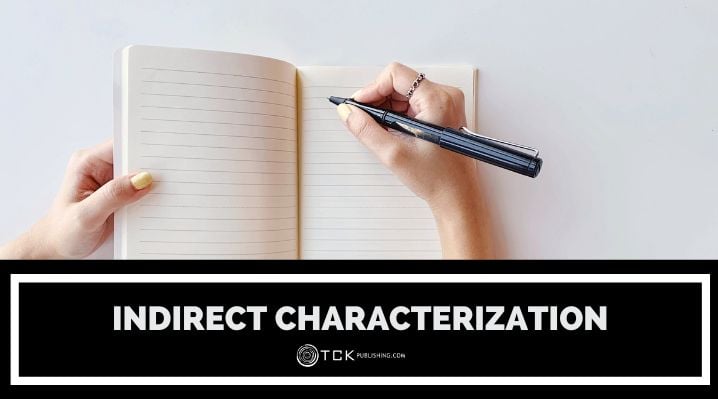
Picture this: A woman enters a coffee shop and orders a large black coffee. She checks her phone twice while waiting. When the barista accidentally gives her a medium instead of a large, she simply smiles and says, “No problem.”
What do you know about this character? You probably think she’s busy but polite, maybe a bit tired but not demanding.
That’s indirect characterization at work.
What Is Indirect Characterization?
Indirect characterization shows a character’s personality through context clues and evidence rather than direct statements. You don’t tell the reader what the character is like. You let them see it for themselves.
Indirect characterization sounds like this:
Cedric always brought extra lunch. “In case someone forgets theirs”, he tells his wife.
While direct characterization sounds like this:
Cedric was a generous man.
Why It’s a Big Part of “Show, Don’t Tell”
“Show, don’t tell” is one of the first things you learn as a writer. Indirect characterization makes that possible.
When you show your character’s traits, you create space for the reader to experience them instead of just reading about them. It makes your audience an active participant in the story.
That builds a stronger connection. It makes the story feel alive by creating vivid and realistic characters your audience wants to discover. And when they figure things out themselves, they care more.
Think about meeting people in real life. You don’t learn about someone because they announce their personality traits. You discover their nature by watching how they behave, listening to what they say, and noticing how others respond to them.
Indirect characterization also adds subtlety to your writing. Real people are complex and contradictory. Someone might be generous with money but stingy with time. These nuances make characters feel authentic rather than flat.
Why Your Writing Needs Indirect Characterization
People reveal themselves through behavior, not announcements. When your characters do the same, they feel genuine.
Character development also happens more naturally. You don’t have to pause the story to explain who someone is. You also avoid pushing readers into a fixed opinion. Instead, you let them draw their own conclusions.
This shows you trust your readers. You believe they can pick up on the clues and read between the lines. That kind of respect builds a stronger connection. It also helps character traits stick because readers discover them on their own.
How to Use Indirect Characterization
You can use five ways to show character traits indirectly:
Through Speech
What a character says, and what they don’t, can show a lot. Pay attention to word choice, tone, and speaking patterns.
Let characters speak in a way that fits their personality. Nervous people ramble. Confident people stay calm.
Listen for what characters don’t say, too. Meaningful silences often reveal more than words. A character who changes the subject when family comes up might have a painful history there.
Example:
“I didn’t ask for help,” she snapped. “I’ve got it under control.”
This line hints at pride, independence, and maybe some anger. You never had to say she’s stubborn. Her words did the work.
Through Thoughts
With internal narration, you can reveal things about your character while hiding them from other characters. What occupies your character’s mental space? How do they react when it comes to outside stimuli? Their response shows their moral compass.
Use it to reveal what your character really thinks but won’t say out loud.
Example:
“Of course they picked her,” I thought. “It’s always her!”
You didn’t tell us the narrator is jealous. You showed us their thoughts.
Through Actions
Small actions often reveal big personality traits. A character’s behavior in tough or quiet moments tells you who they are.
How does your character treat someone else? What do their habits say about them? These details show values and character.
Watch for contradictions between what characters say and do. A character who claims to care about the environment but throws trash out of car windows reveals hypocrisy or self-deception.
Small choices matter. Even simple actions can hint at deeper traits, especially if they’re often repeated.
Example:
He watched the rain-soaked cat. Then, without a word, he opened the door and let it in.
You can guess he’s kind, even if no one says so.
Through Other Characters’ Reactions
Sometimes, the way others treat a character says more than the character does.
If everyone interrupts a character, that person probably lacks authority or confidence. If people seek someone’s advice, that character likely has wisdom or experience.
Use group dynamics, body language, and dialogue to show how people respond to one another.
Example:
Everyone went quiet when James walked in. They avoided his gaze, pretending to be occupied with something else.
The silence and awkwardness suggest something about James’ past. You didn’t have to spell it out.
Through Appearance and Environment
What characters wear and how they wear it tells stories. Perfectly pressed clothes suggest attention to detail or concern about image. Mismatched socks might indicate creativity or distraction.
A character’s space says a lot, too. A cluttered desk with family photos shows different traits than a sterile, organized workspace. Look at what characters choose to display, hide, or keep close.
Even body language matters. Crossing arms can signal defensiveness. Constant eye contact might show confidence.
Use sensory details, what readers see, hear, and smell in a space, to reflect their personality.
Example:
She sat on her bed, staring at the wall across the room. It was covered in so many travel maps and postcards, you could barely see a spot of paint.
Now you know she’s adventurous.
Direct vs. Indirect: When to Use Each
Indirect characterization is great, but it’s not always the best option.
Use direct characterization when:
- You want to establish a trait quickly.
- The trait isn’t central to the story.
- You’re introducing a side character.
Use indirect characterization when:
- The trait is important to the story or theme.
- You want to create mystery or surprise.
- You want to make the reader feel more involved.
Example:
She was stubborn, and everyone knew it. But it wasn’t until she stood up in that courtroom—alone, trembling, and angry—that I truly understood how deep it ran.
Of course, these aren’t hard rules. Use your creative judgment.
How POV Affects Indirect Characterization
Point of view changes how you reveal character traits.
In first person, you’re inside the character’s mind. You can show what they think, notice, and feel—plus what they ignore or avoid. This helps readers understand them on a deeper level.
Third-person limited is similar. You still follow one character closely, but with a bit more distance. You control what readers know and when they know it.
Omniscient POV is broader. You can jump between characters and get a wide view of the story. However, it creates more distance between the reader and each character. To show traits, you’ll need to rely more on what characters do, say, and how others react to them.
Use the POV that best matches the depth and style of characterization you want to achieve.
How do you use indirect characterization? Share your thoughts below!
If you enjoyed this post, then you might also like:
- Characterization: How It Connects Readers to Your Story
- How to Write Character Arcs: Adding Depth to Your Story’s Players
- 6 Steps to Creating a Great Character
- How to Create a Character Profile: Complete Guide with Template

Cole is a blog writer and aspiring novelist. He has a degree in Communications and is an advocate of media and information literacy and responsible media practices. Aside from his interest in technology, crafts, and food, he’s also your typical science fiction and fantasy junkie, spending most of his free time reading through an ever-growing to-be-read list. It’s either that or procrastinating over actually writing his book. Wish him luck!
